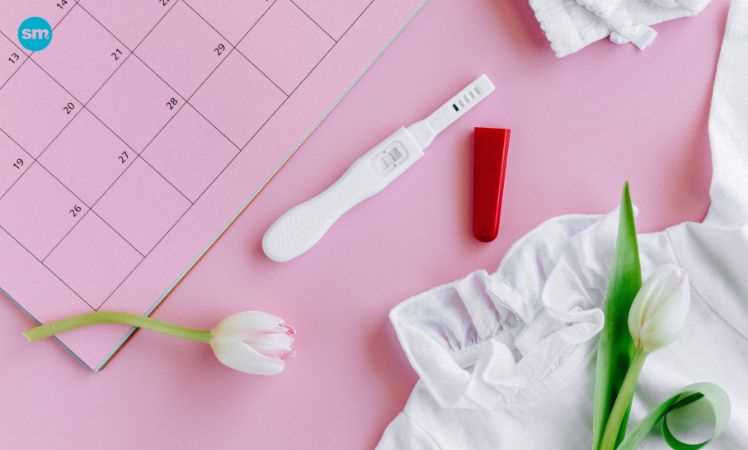Last updated on May 2, 2024 by Kathy
Have you ever wondered when in your menstrual cycle you are most likely to get pregnant? Tip: It’s all about when you ovulate. Ovulation is a critical part of the menstrual cycle, when eggs are released from the ovaries, giving them the best chance of fertilization and pregnancy.
Accurately calculating when you ovulate can be a science, and there are a few different ways to help track this important window. There are actually 9 ways.
Why it’s important to know when you ovulate
Knowing when you ovulate is crucial, especially if you’re trying to get pregnant. Ovulation marks the time in the menstrual cycle when an egg is released and ready for fertilization, making it the most fertile time. By pinpointing this window, you can greatly increase your chances of conception by timing intercourse or insemination appropriately.
Understanding your ovulation patterns can help detect fertility problems early and facilitate informed discussions about reproductive health with your healthcare provider. Whether you’re planning a baby or monitoring your health, figuring out when you ovulate can help.

9 Different Ways to Track Your Ovulation
There’s more than one way to track ovulation, giving you multiple options for planning ahead. Here are nine different ways to determine when you might be ovulating.
1. Traditional calendar
The traditional calendar method is one of the easiest ways to predict ovulation, but it requires regular tracking and consistent cycles. To use this method, you need to mark the date on your calendar when your period starts. Then count forward 14 days (half of the average menstrual cycle).
Note, however, that this method is not without errors, as the typical menstrual cycle can fluctuate and affect the timeline. If your regular cycle length is longer or shorter than 28 days, consider adjusting your calculations accordingly to ensure this method works wonders.
2. Ovulation App Tracker Method
In today’s digital age, the ovulation app tracker method provides a simple and convenient way to predict ovulation. With apps like Flo, Monthly Cycle and Ovulation Tracker, you can fully track your menstrual and ovulation cycles on your smartphone or tablet.
These apps use algorithms to predict when you are likely to ovulate based on the information you enter each month about your menstrual cycle length and symptoms. While more accurate than calendar methods, they are still general estimates based on averages and available data.
3.Basal body temperature method
The basal body temperature (BBT) method is a more scientific way to understand the ovulation cycle. It involves tracking the slight increase in body temperature that occurs after ovulation due to hormonal changes. This temperature is usually lower before ovulation (between 96-98° F).
To use this strategy, take your temperature every morning before you get up. Over time, you’ll notice a pattern: A small but consistent increase in body temperature indicates that ovulation may have occurred. This is the best time for intercourse or insemination.
4. Cervical mucus method
The cervical mucus method involves monitoring changes in cervical mucus throughout the menstrual cycle to predict ovulation. Typically, cervical mucus changes from a dry, sticky state at the beginning of the menstrual cycle to a clear, stretchy state, or becomes as thick as raw egg white around the time of ovulation. As estrogen levels begin to rise, discharge may appear moist/creamy and/or cloudy.
This change is caused by hormonal fluctuations as your body prepares for potential pregnancy. By observing these changes closely each day, you can identify patterns that signal ovulation is imminent. However, this approach requires familiarity with normal mucus changes.
5.Cervical spine positioning method
Cervical positioning is another technique that focuses on the physical changes in the body throughout the menstrual cycle. Specifically, it involves observing changes in the position and sensation of your cervix, which can indicate that ovulation is imminent and whether you are pregnant.
Generally speaking, at the beginning of your menstrual cycle, your cervix may feel hard and low in the vagina. However, as ovulation approaches, it usually becomes softer, taller, and more open. To use this method effectively, you should regularly check the position of your cervical spine (with clean fingers!).
6. Symptomatic heat method
The Symptothermal Method is a comprehensive approach that combines several techniques to identify ovulation. It includes charting your basal body temperature, monitoring changes in cervical mucus, and understanding physical symptoms related to ovulation.
For example, these symptoms may include abdominal bloating, mild pelvic pain, or breast tenderness. When you combine these factors, it gives a more complete picture of your fertility status and allows you to more accurately predict your most fertile days.
7. Ovulation prediction kit
If you prefer a more scientific approach, the Ovulation Prediction Kit (OPK) may be an excellent tool for predicting your cycle. These kits function much like pregnancy tests, but are designed to detect the surge of luteinizing hormone (LH) that usually occurs before ovulation.
When a test detects a surge of LH in the urine, it’s a telltale sign that ovulation is imminent, usually within 24 to 36 hours. OPK allows you to accurately time intercourse or insemination for the best chance of conception. They’re readily available on the counter and easy to use.
8. Saliva Fern Test
The saliva fern test is a unique method of detecting ovulation that involves examining saliva under a microscope. During ovulation, rising estrogen levels cause a distinct “fern” pattern in dry saliva. This is a really cool phenomenon!
By observing this pattern, you can predict ovulation. This method requires the purchase of specialized optical equipment and some practice to accurately identify fern patterns. However, once you become familiar with what to look for, these tests can be an effective and non-invasive tool.
9. Have regular sex
While this method doesn’t track your ovulation cycle, it does make it easier for you to conceive. After all, if you have sex every two days, there’s no need to track ovulation. Since ovulation lasts 24 to 48 hours, there is a good chance of having sex during ovulation.
That being said, this method is best used in conjunction with ovulation tracking. Once your fertile window is determined, having sex every 1 to 2 days can increase your chances of conception.
There are other ways to further improve your odds. For example, you can engage in gestational intercourse and certain sexual positions to help create the perfect environment for conception. Tracking ovulation is only really necessary if there are scheduling challenges.
In summary…
There is a wealth of knowledge available when it comes to understanding your fertility cycle. It’s all about choosing what works best for you and being consistent with it. Whether you’re trying to get pregnant or just want to understand your body, tracking ovulation can be beneficial.




